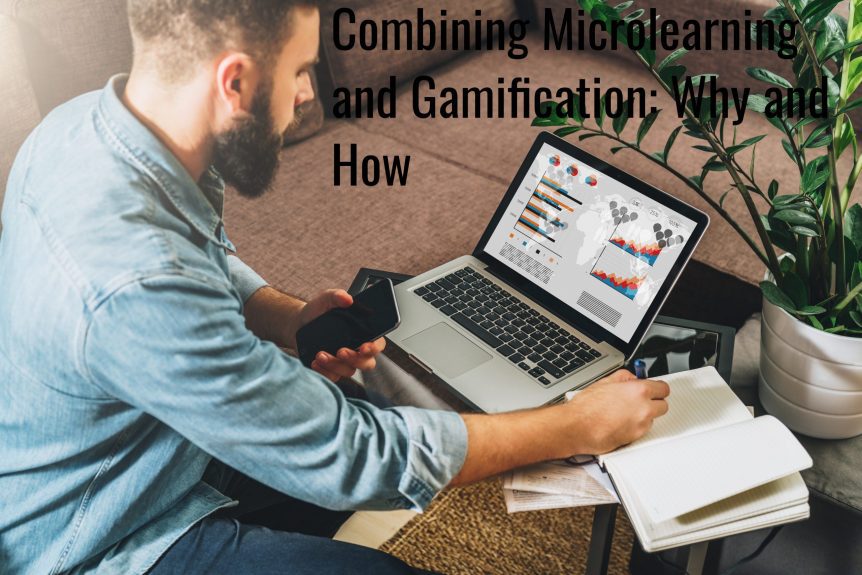Combining Microlearning and Gamification: Why and How
E-learning isn’t just about making offline training content available online. Instead, e-learning opens up a wide range of highly effective training strategies that will help you improve results and return on investment. Two of those strategies are microlearning and gamification.
You often see one of these strategies in a training course, but not both. There is no reason for this, as microlearning and gamification can go together. In fact, you can improve results even further by combining microlearning and gamification elements in a single e-learning course.
Microlearning Recap
Let’s quickly run through a recap on both strategies, starting with microlearning. Microlearning involves presenting information to learners in short, bite-sized chunks. Each element is focused on a single topic or outcome and should only take a handful of minutes to complete. The overall e-learning course is a combination of the bite-sized chunks.
Microlearning offers considerable advantages to organisations across the UAE and Saudi Arabia as it fits in with how people learn. Examples include learning on the go or learning when you have a few minutes to spare before moving onto another task.
The strategy involves ensuring the learner has a good grasp of each individual point without distracting them with other information. When done well, this leads to a deep understanding of the topic.
Gamification Recap
This e-learning strategy involves using gamification elements in e-learning courses with the aim of achieving a learning objective in the most engaging way possible. Examples of gamification elements include:
- Levels that learners can progress through like they do in a game.
- Challenges to complete within levels.
- Scores to measure success as well as providing learners with instant feedback.
- Badges to display achievements.
- Competitions and leader boards to add a social element (and competitive element) to the e-learning experience.
Importantly, gamification elements are not just about making e-learning courses fun. This is one benefit, and it’s an important one, as learners will be more likely to engage with the content if they are enjoying the training.
Gamification in e-learning is also about improving the learner experience and retention levels. In other words, it can be a highly valuable training tool.
The Perfect Match – Gamification and Microlearning
You don’t have to pick one or other of these two e-learning strategies, as they are highly effective when they are combined. The benefits of using both microlearning and gamification in a single e-learning course include:
- Higher levels of engagement – gamification encourages greater participation in e-learning courses, while the microlearning approach means learners don’t have to allocate large amounts of time to go through the content.
- Improve learner motivation – learner motivation is an important part of training in most organisations. You will struggle even before learners begin the course if they view the training as a burden or chore. Both microlearning and gamification will improve motivation levels, as the training will be more enjoyable, and the learner will feel a greater sense of accomplishment without feeling they are falling behind in other areas of work.
- Improve knowledge retention – for most corporate training, knowledge retention is one of the main objectives, whether you want to increase the knowledge or skills of your team, or you want to change behaviours. Using e-learning and gamification together will facilitate learner knowledge retention.
- Return on investment – the above benefits will combine to improve return on investment for the e-learning courses you create.
Tips for Combining Microlearning and Gamification, and How to Do It
There are two crucial points to remember if you are thinking of using both gamification elements and microlearning in your e-learning courses:
- Have a clear objective – don’t use a microlearning approach for the sake of doing so. Instead, you should consider the topic in detail, the learners, and what you want to achieve. The same applies to gamification. Gamification elements that are thrown in probably won’t work. Those that have a clear objective will.
- Ensure there is proper investment in development – using both microlearning and gamification adds an additional layer to course development, so it’s important you allocate the right resources.
How can you add gamification elements to an e-learning course built using a microlearning strategy? Here are three ideas:
- Gamified learning paths – instead of learners moving from bite-size chunk to bite-size chunk and section to section, you can gamify their progress, visually representing that progress on the screen. You can also award badges or points, similar to the mechanics of a game on a game console, but with a learning focus.
- Gamify assessments – use gamified assessments instead of standard quizzes. One of the ways to do this is by adding a competitive element, such as a leader board.
- Gamify practice elements – this one particularly applies when the e-learning course involves learning a new skill, but it has applications with other topics too. It involves gamifying the elements in your e-learning course that enable learners to practice their new skills. To do this, you can add scores, awards, badges, a leader board, etc.
This is Not a Gimmick
Finally, it is important to have buy-in from everyone involved that the use of gamification elements or a microlearning strategy are not gimmicks. Both are serious and beneficial training tools that can deliver real results. Combining the two in e-learning can enhance those results, increasing the benefits to your organisation.

